Abstract
SCAS (Socrates as a Service), incorporating ChatGPT 3.5, was instructed to create ten visions for the future waiting room of the doctor, based upon positioning the waiting room as part of the continuum of healthcare, rather than just a room housing people before they are admitted to see the medical professionals. SCAS ‘fleshed out’ each of the 10 visions in paragraph form, and then generated 15 questions about aspects of implementing these visions. In the subsequent iteration, SCAS was given the 15 questions it had previously created, and instructed to provide answers to each question, as well as estimate the difficulty involved in achieving what the answer specified. At the end of the process, about 15 minutes later, the program returns with a detailed Microsoft Excel file, the Idea Book, showing each iteration, and providing additional insights generated by the AI-based ‘Summarizer.’ The process presented here shows the power of AI to help create the future by allowing easy-to-create, quick-to-run queries, and providing detailed answers and additional subsequent analysis. With the turn-around time in seconds, and with a system which is iterative, the user can explore a topic in depth, generating a strong educational experience for any topic that one can imagine. The strength of the approach is the ability to help one think and envision in a way which is absorbing, user-driven, and often filled with surprises.
Introduction
What the future will bring is always a topic of conversation. It becomes especially interesting when the focus is on something relevant to the daily lives of people, and when the evolution may improve the quality of life. This paper is an attempt to envision the doctor’s waiting room as part of a smooth transition from greeting the patient to treating the patient. The strategy uses AI to help envision the future, doing so in a way which requests specificity from AI. Furthermore, the objective is to integrate OpenAI’s freely available AI ChatGPT 3.5, a large language model (LLM), into an easy-to-use system with a limited number of queries, automatically built-in. All the work is done behind the scenes by ChatGPT 3.5 [1]. The objective is to create a system which lets the user focus on the work, not on the effort to code. As a result, the user spends time learning through iterations, the immediate feedback allowing a quick change of query, with the iterations eventually generating the information desired. The notion here is that AI becomes the collaborator in the up-front development, and in some cases a participant who estimates the difficulty of the task [2,3].
The approach used in this paper is called SCAS, an abbreviation for Socrates as a Service. The name comes from the belief that the approach presented here is a coach to creative thinking. Rather than Socrates ‘pulling out’ ideas from the mind of slaves through questioning, the idea is for people to pull out ideas from the mind of AI through questioning. The questions are not meant to be factual, but conceptual. The user is challenged to let Socrates give expansive answers, not constrained ones, while at the same time ensuring that these expansive answers are feasible and produce something tangible. [4] called this approach ‘Homo Silicus.’
Systematizing New Idea Creation
Creating new ideas is a well-accepted business objective. Business always needs to create ‘new’ for the simple reasons that business must keep up with changes, whether the changes be responses to truly new situations and their requirements, or activities to maintain the interest of fickle customers. The world changes, people get tired of what they have, the two of these factors combining to force the creation of the new as a standard part of one’s operations, one’s business.
With all the focus on ‘new,’ it should come as no surprise that there are myriad publications with their pronouncements of how to create the new, hundreds of thousands of experts who are ready to advise about the ‘new’ at a moment’s notice and for an agreed-upon fee, not to mention the multitudinous best practices which dot the horizon of business.
The introduction of AI has changed the world of new product development. With user-friendly technology such as that embedded in Open AI’s ChatGPT 3.5, it has become possible to provide AI with a specification, a request, and let AI return with the suggestions. It is from experience with AI in this format that the study reported here arose. The paper focuses on the application of AI to envision the patient’s waiting room, an integral part of the medical facility, as a room where the healing process begins.
The process presented here grew out of the effort to understand how people respond to the world. The typical process of understanding the mind of a person with respect to something like the patients’ waiting room is to ask questions about the waiting room, to identify the relevant features, and their importance. The typical approach is to use some type of scale and instruct the respondent to rate the importance of different features that the waiting room might feature. It is from this type of scaling that the designer gets a sense of what is important. It is up to the designer to then take the information and create the prototype rooms to be evaluated for acceptance, utility, and so forth. Sometimes the survey is put aside or occurs after a discussion with participants about the new patient’s waiting room. In this case a trained interviewer discusses the nature of the waiting room, either with one or two people in a so-called ‘depth interview’ or convenes a group of people called a ‘focus group’. In both cases the researcher ends up conducting a structured interview in the form of a conversation. The foregoing process is a standard part of most research approaches to understand what is needed in a new product.
One emerging problem embedded deeply in the foregoing conventional process is the failure to deal with the details. Surveys, discussions, and so forth can provide direction, but it is the execution of these ideas which is important. In research this is known as the gap between ‘strategy,’ the big idea, and ‘execution,’ making the particulars a reality and bringing that into the world. The emerging science of Mind Genomics was developed to incorporate the specifics, the executions, into the research process [5]. Rather than instructing the respondent to rate general ideas, hoping that these ideas would end being well executed, the Mind Genomics approach took its cue from nature. The approach was to create small vignettes, combinations of concrete ideas, specific descriptions, instruct respondents to rate these vignettes, and then through statistics (regression, clustering) deconstruct the response to the part-worth contribution of the individual concrete elements, the granular information shown to the respondent . The outcome was the recognition that valuable data could be obtained by focusing on the specifics of a situation, rather than focusing on large, featureless, general ideas. A good strategy was to generalize from the pattern of particulars, easier to do than particularizing from a featureless generality. It was this realization which pushed the focus of Mind Genomics to focus on the concrete, the granular.
It was the pattern of questions and answers, begun with Mind Genomics, which was to evolve to the approach presented here. In its current form, Mind Genomics requests the user to create four questions regarding a topic (see Figure 1, Panel A), and then for each of the four questions create four answers (see Figure 1, Panel B). The process thus creates 16 elements, the four sets, each comprising four answers. It was the ensuing difficulty with having a user, develop four questions which eventuated in introducing AI was used as a coach, called, not surprisingly, the Idea Coach. The user would type background to a topic in the form of an AI prompt, which Mind Genomics calls a ‘squib’ (Figure 1, Panel C). In turn, the Idea Coach would then use AI to develop the four questions. (Figure 1, Panel D). The same approach could be used to create four answers to each question. The process of using AI a system to generate questions for a specific topic, or answers for a specific question soon moved AI to a central role in Mind Genomics.

Figure 1: The original process in the set-up of a Mind Genomics study. Panel A shows the request for four questions which ‘tell a story’. Panel B shows one question, with the request to provide four answers. Panel C shows the background to the project and the desired results, the so-called ‘squib’, typed into the Idea Coach. Panel D shows 5 of the 15 questions provided by SCAS operating within Idea Coach.
It soon became apparent that the embedded AI in Mind Genomics was being used far more to create ‘books of knowledge’. The user would create a set of questions to ‘brief’ the AI, and then run the AI several times, occasionally just iterating, but often changing the input slightly and then iterating. The emerging focus was using the embedded AI to provide a range of alternative answers to the same question. Furthermore, the AI had been programmed to provide additional summarization, viz., post-emergent analysis. The system ended up being renamed SCAS, Socrates as a Service, in recognition of this evolution from a system which recommended questions and answers into a system to educate people on a topic, using AI to help people think critically about a topic, imagine alternative realities, and create by typing descriptions of those realities.
Using AI to Drive the Future
The immediate stimulus driving this set of experiments resulted from a fortunate accident. than simply asking a question and getting the SCAS to provide 15 answers, something that was done a dozen times in the set up of a Mind Genomics study, the user this time created a more detailed briefing, by writing down both the relevant input for Idea Coach, but then additional, background information that was usually part of the thinking, but never submitted to the AI in Idea Coach. The AI was ‘briefed’ in a far more detailed way, with thoughts, requests, hypotheses, and so forth, again by accident, but an accident which proved remarkably productive as shown below.
Table 1 show the entire briefing. Table 1 is divided into two parts, shaded and unshaded, respectively. The shaded parts provide modest details, specifically the nature of the room (part of the flow, first room in a sequence of room), followed by a statement of ‘fact’, viz., that there are ten mind-sets. There is no supporting evidence given for the statement about ten mind-sets, however. The user could just have easily specified three mind-sets or 13 mind-sets. The second part of Table 1 shows the general instructions to the AI. These are to focus on the room itself, and afterwards on the reaction of people to this room. Again, Table 1 is far more extensive. We can contrast this extensive brief with the ordinary brief of that time, which would be something like: ‘What are questions to ask about the nature of the patient’s waiting room, if we think of the next decade, starting in 2030?’
Table 1: The briefing given to AI about the waiting room outside the doctor’s office

The actual creation of the AI briefing takes a few minutes. Once the AI is provided with the briefing, the AI is invoked through SCAS, the Socrates as a Service procedure, embedded in the Mind Genomics program. Within 10-20 seconds the AI returns with preliminary answers along with an additional set of 15 questions for consideration..
Table 2 presents the 10 visions of the patient’ waiting room, attempting to follow the request to discuss the room itself as an integral part of the visit, and of the continuum from waiting room to examination room. Each of the 10 visions is labelled, followed by a description of the room itself, and then followed by the response of the patient in that room.
Table 2: The 10 visions for the patient’s waiting room as part of the continuum for health and healing. Each vision comprises a name, a description of the room, and then a description of the feelings of people towards that ‘now-evolved’ space.
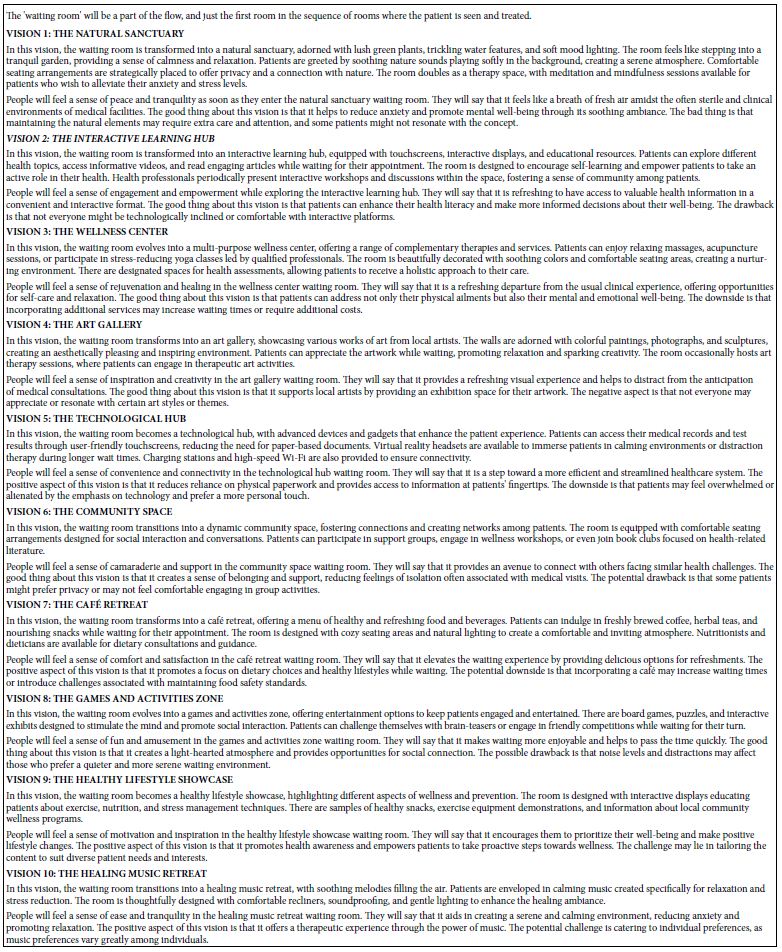
The important thing to keep in mind is that the AI was not given any information at all, other than this was to be a patient’s waiting room but was also going to be part of the spatial continuum, and thus an integral part of the ‘path’ for health and healing.
As noted above, each iteration was accompanied by 15 questions to answer. These questions are based on the topic. The questions emerge automatically. The next step was to copy the 15 questions into a new run of Idea Coach. Table 3 shows the 15 questions (underlined), two answers to each question provided by SCAS and for each question an estimate of the difficulty of achieving that answer (Easy vs Difficult).
Table 3: The 15 questions generated by SCAS when it provided information about the vision, along with two answers to each question, and the estimated difficulty of implementing the answer. The questions were ‘answered’ by a separate run of SCAS, where the questions were inserted as part of the briefing to AI.
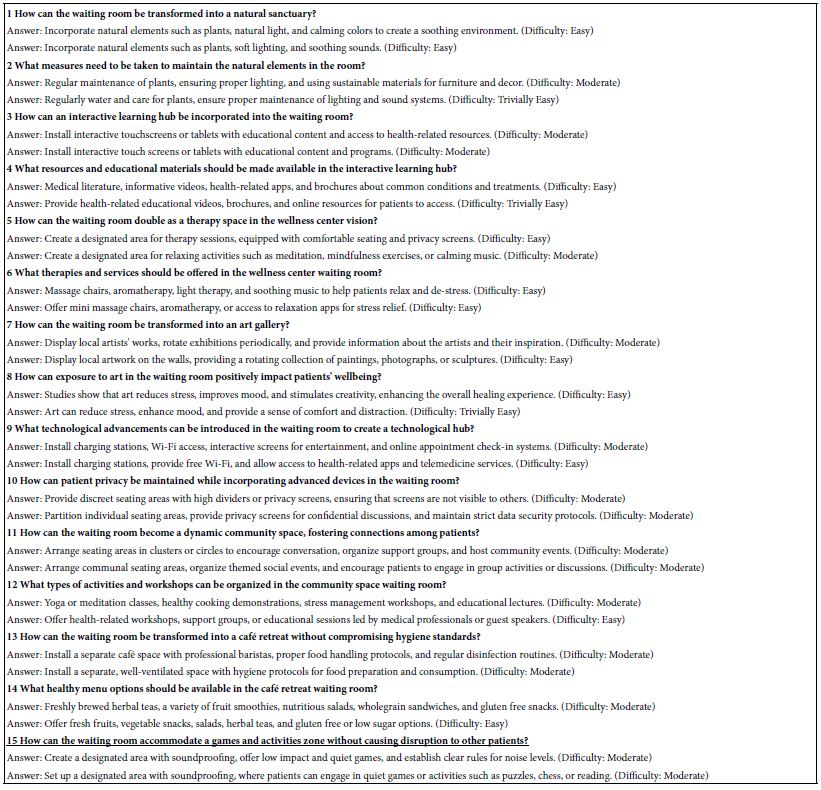
Summarizing and Expanding the Ideas; Themes and Perspectives
SCAS generates a great deal of information when it creates visions (Table 2) and generates questions (Table 3). One of the benefits of AI is the ability to summarize the information in a succinct way. Table 4 shows two summarizations. The top of Table 4 shows the key ideas. The bottom of Table 4 shows the four themes identified by SCAS, followed by the good (plus), bad (minus) and novel (interesting) aspects of each theme. It is in Table 4 that we begin to see a secondary analysis by AI of the information generated by AI.
Table 4: Key ideas, themes and perspectives
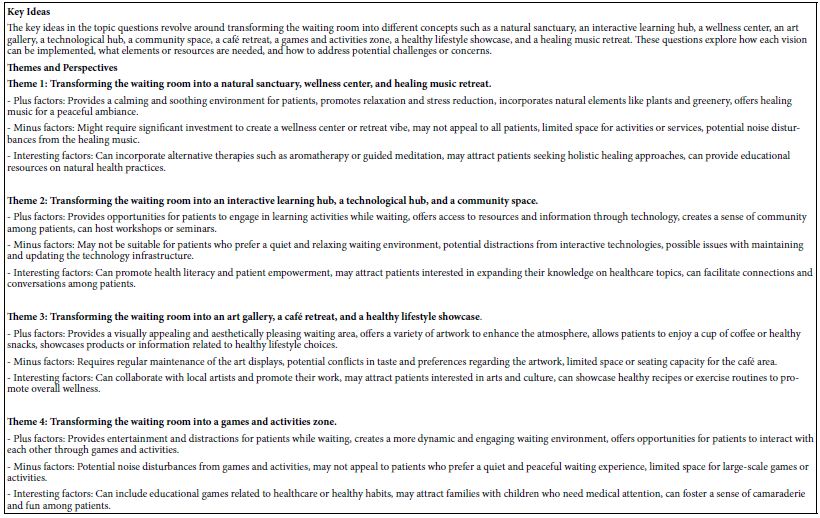
Table 5 moves the analysis to who would be interested in these ideas, and who would be opposed to them. Once again we see a deeper secondary analysis of the information provided by AI.
Table 5: Interested versus opposing audience to the topic ideas

Driving Towards Innovation
Table 6 shows the final analysis provided by AI, comprising three sets of analyses/questions which drive towards innovation. The first comprises a set of 10 questions about what is missing. This first set is meant to challenge the user. The second comprises a set of 16 alternative viewpoints, contrasting answers to a question. The third focuses on innovations, comprising a set of four general categories or topics, each with several suggestions.
Table 6: Steps toward innovation, comprising ‘what is missing,’ alternative viewpoints, and then categories or topics with several suggestions each.
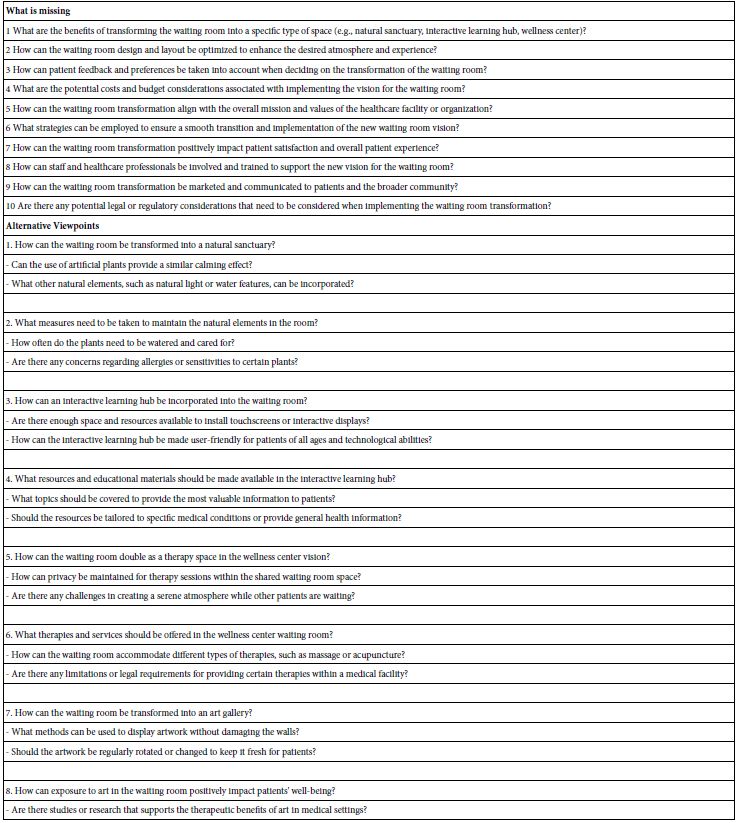

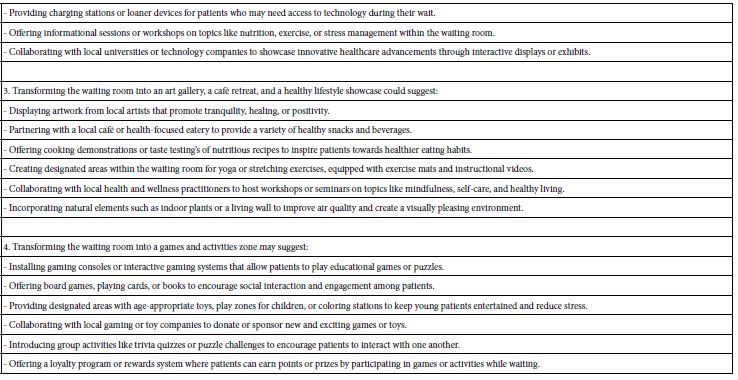
Discussion and Conclusions
The focus of this paper is to present an approach to solving specific problems, once these problems are specified and provided to AI in a useful manner. The AI approach used here, SCAS, Socrates as a Service, was developed to help critical thinking, and to focus attention on potential answers. Rather than focusing the time on elaborating the question, SCAS builds on the richness of AI, especially in the world of design. The effort shown here revolves around the desire to structure a development effort, or perhaps even a research effort.
As we consider what has been presented here, it should be kept in mind that the work presented here belongs to the world of philosophy of science, specifically the topic of ‘hard to define’ problems [6]. [7] presented the issue which summarizes the thrust of this paper. In their words: “‘The formulation of a problem is often more essential than its solution’….To raise new questions, new possibilities, to regard old problems from a new angle, requires imagination’ Yet, how the creative process unfolds in framing ill-defined problems remains an open question. Indeed, untangling the interrelation between problem framing and the creative process in its lower-level aspects can inform scholars.. Problem framing entails building mental representations that simplify the problem..”
At this point, once the results of the effort have been presented, it may well be productive to contrast what has gone on in this paper versus the standard scientific or brainstorming effort which characterizes current research. Conventional research begins with observations, a hypothesis, and then establishes the validity or the falseness of that hypothesis through one or more experiments. The objective of science is to amass many hypotheses that have been shown to be correct, or more precisely, have not been falsified from experiments. The current research follows a different approach, one which ‘explores’ rather than confirms. The term ‘cartography’ is appropriate here. The approach here is ‘mapping’ the topic, almost as an explorer maps an area that is unknown. Knowledge becomes the accretion of these cartographies, and human advancement may end up through the application of these cartographies, the applications showing up in changes in the worlds of the material and of experience, respectively.
References
- Binz M, Schulz E (2023) Using cognitive psychology to understand GPT-3. Proceedings of the National Academy of Sciences 120(6)
- Kitadai A, Tsurusaki Y, Fukasawa Y, Nishino N (2023) Toward a novel methodology in economic experiments: Simulation of the Ultimatum Game with large language models. 2023 IEEE International Conference on Big Data 3168-3175.
- Gray K, Dillon D, Tandon N, Yuling G (2023) Can AI language models replace human participants? Science & Society. Trends Cogn Sci 27: 597-600. [crossref]
- Horton J.J (2023) Models as Simulated Economic Agents: What Can We Learn from Homo Silicus? National Bureau of Economic Research Working Paper 31122.
- Moskowitz HR (2012) ‘Mind Genomics’: The experimental, inductive science of the ordinary, and its application to aspects of food and feeding. Physiology & Behavior 606-613. [crossref]
- Garbuio M, Lin N (2021) Innovative idea generation in problem finding: Abductive reasoning, cognitive impediments, and the promise of artificial intelligence. Journal of Product Innovation Management 38: 701-725.
- Pham CTA, Magistretti S, Dell’Era C (2023) How do you frame ill-defined problems? A study on creative logics in action. Creativity and Innovation Management 32: 493-516.